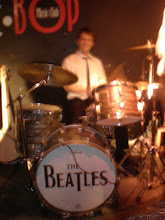I visited Paris for the first time nearly 10 years ago. I was only 11 and traveling with an orchestra on a tour of Europe for 17 days, so as you can imagine, we were being shuffled here and there for performances, museum visits, etc. In addition, the city was erupting in a World Cup frenzy of excitement, making it even more challenging to enjoy the city's beauty and making the French even more impatient with Americans lacking any French-speaking abilities. This initial and somewhat disappointing first impression of France and Paris in particular, was enough to convince me never to return.
However, this entire experience was before I fell in love with The Doors.
Studying in Italy has provided me and each of the students here with a unique opportunity for travel. Thanks to the efficiency of trains and affordability of flights, we all came here with the expectation to see as much as possible. Though I had promised myself never to return to Paris, it was first on the list of places to see for many of my friends here in the program. I was hesitant to agree to the trip because of my previous experience and because of my long list of other places to see, but after weighing the options, decided to make the trip. Though I had seen the Louvre, Notre Dame, The Arc de Triumph, and the Eiffel Tower, there was another landmark in Paris which I had been completely unaware of during my previous visit: Jim Morrison's grave.
My interest in The Doors began my senior year of high school at a local library. I had been researching the evolution of rock and roll music for a paper when I came across a book by the drummer of The Doors, John Densmore called "Riders on the Storm". Out of nothing more than curiosity, I decided to check the book out. Though I read the book by chance, my behavior since has been very deliberate.
Reading Densmore's book did more than spark my interest in the band and Morrison in particular, but in rock history in general. Since reading "Riders on the Storm", I have also read various books about Johnny Cash, Bob Dylan and John Lennon and have become an avid reader of music magazines including Rolling Stone, Alternative Press, Spin and Paste. However, I still remain most interested in The Doors, their short-lived peak of fame and the mystery surrounding their front man, Mr. Mojo Risin' (move those letters around and see what they spell), James Douglas Morrison.
Morrison was born December 8, 1943 in Melbourne, Florida, but was destined to a life of travel as his father, Admiral George Stephen Morrison was active in the United States Navy. In 1947, when he was only 4-years-old, he witnessed a car accident involving a family of Native Americans while traveling in the desert with his own family. This experience found its way into multiple future-Doors songs including "Riders on the Storm" and "Peace Frog" and for the rest of his life, Morrison would consider the incident be one of his most influential experiences. However, his family does not recall ever seeing accident.
Though Morrison is most well-known for his activity with The Doors, he attended college for film at St. Petersburg Junior College, Florida State University and UCLA, and published two volumes of poetry in 1969, The Lords/Notes on Vision and The New Creatures. These were the only volumes of Morrison's poetry released during his short lifetime.
After graduating from UCLA, Morrison teamed up with fellow classmate and future keyboardist of The Doors, Ray Manzarek to form the group with guitarist Robbie Krieger and drummer John Densmore. The name of the band was inspired by an Aldous Huxley book, The Doors of Perception which borrowed a line of poetry from William Blake. "When the doors of perception are cleansed/Things will appear as they are, infinite." This quotation was one of many which inspired Morrison, an avid reader of such writers including Charles Baudelaire, Arthur Rimbaud, Jack Kerouac and especially the philosophical works of Fredrich Nietzsche.
The Doors released six studio albums between 1967 and 1971 and influenced the future of rock and roll within their limited run. Though they were only actively touring and recording for less than a decade, they left behind an impressive catalog of rock music classics including “Peace Frog”, “L.A. Woman”, “Light My Fire”, and “Touch Me” and Morrison’s style has inspired rock generations ever since. The prototypical sexy and mysterious rock star image and legendary leather pants have been used as a model for later artists including Roger Daltrey, Mike Love, Robert Plant and Iggy Pop.
However, their striking success was also marred by the destructive and ultimately deadly tendencies, primarily of Morrison, which led to lawsuits, disagreements and the demise of a band and a life that had barely begun.
Jim Morrison was found dead on July 3, 1971 by girlfriend, Pamela Courson in his Paris apartment bathtub.
In accordance with French law, no autopsy was performed because no foul play was suspected, so precise cause of death has remained unknown. Local French doctor Max Vasille examined Morrison’s body and “heart failure” was the announced cause of death, though this was later considered suspicious because Morrison’s personal physician in the United States stated he “was in excellent health before traveling to Paris.”
The manager of The Doors, Bill Siddons, released an official statement claiming Morrison had died peacefully of natural causes though he chose not to view the actual corpse.
Besides Siddons, none of Morrison’s friends or family had the opportunity to see the body as a three-day news blackout followed the abrupt death and the body was quickly taken and buried at Pere-Lachise, one of the most famous cemeteries in the world where other notables including Moliere and Oscar Wilde are buried. Being a national French cemetery, it is unusual that a foreigner was allowed a place among such distinguished company. Furthermore, the site remained unmarked for several months following the burial and upon viewing the gravesite, Doors drummer, John Densmore claimed the grave was too short.
Since Morrison’s death, other suspicions have surfaced concerning cause of death and whether The Lizard King died at all.
Conversations with Courson have revealed a heroin overdose as a possible cause of death as Morrison had inhaled the substance mistaking it for cocaine. However, Courson also reported various contradicting stories including versions where his death was her own fault. Unfortunately, Courson died four years later, like Morrison, at the age of 27, of a heroin overdose.
This past July 2007 another story surfaced as described by Morrison’s friend Sam Bernett in which the rock icon died of a heroin overdose in the Rock n’ Roll Circus nightclub. After overdosing, Morrison was taken back to his own apartment by the dealers who sold him the heroin that night. Allegedly, those who witnessed the event were sworn to secrecy in order to preserve the reputation of the well-known nightclub.
Though there are other theories concerning more mystic and spiritual reasons for Morrison’s death, the other most popular theory is, of course, that he never died at all. Morrison had mentioned pulling a “death stunt” in 1967 as a means of gaining press attention for the band and had also discussed the desire to “radically change careers, reappearing as a suited and neck-tied businessman.”
Stories still surface today of sightings around Paris, radio interviews in the Midwest, eerie phone conversations and mysterious withdrawals from bank accounts in the singer’s name, but no definitive evidence has been shown to prove the singer is alive. Yet little has been shown to actually prove him deceased. (Several years back a group of avid Doors fans even went so far as to try and compare Morrison’s dental records to the buried body’s remains, but failed to gain access to the body.)
Further fueling the fire, Ray Manzarek was also quoted as saying, “If there was one guy that would have been capable of staging his own death, getting a phony death certificate and paying off some French doctor… putting 150 pound sack of sand into a coffin and splitting to some point on this planet, Africa, who knows where, it is Jim Morrison who would have been able to pull it off.”
This was a lot to consider when staring at the unimpressive grave. Though finding the cemetery was easy (it is one of the most famous and visited sites in France), finding Morrison’s grave was not. The cemetery is a mess of stones and pathways, weaving without rhyme or reason up and down a gigantic hill decorated with gravesites and memorials to some of the greatest artists and most famous French families dating back hundreds of years.
Morrison’s grave is oddly placed, sandwiched awkwardly between other unknown graves with no definitive marking other than the young people in tye-dye staring at the stone behind a small metal gate blocking direct access to the grave. Flowers decorate the modest stone and the name is barely legible, even from the closest possible point.
It was not what I had expected. I remembered pictures of the grave with a bust of Morrison marking the site, but remembered upon my arrival that it was defaced and later stolen. Prior to that, French officials had placed a shield over the grave, but that too was stolen.
However, what most interested me about the simple site was the Greek inscription below the name and date of my favorite artist, singer and poet of all time: “KATA TON AAIMONA EAYTOY”, meaning “true to his own spirit.”
Whether dead or alive, and for whatever reason, Morrison was, true to himself. Without fear or apprehension of the rest of the world, Mr. Mojo Risin’ progressed forward in his own desired direction throughout his tumultuous career and life and remains a unique icon of rock and roll and the psychedelic musical era he helped to define.
Leaving Paris, I was satisfied. Though I and the rest of the world may never know the truth of Morrison’s death or lack thereof, we can still remember his contributions to music, art and culture and move forward, always mindful: “The future’s uncertain and the end is always near…”
Subscribe to:
Post Comments (Atom)










No comments:
Post a Comment